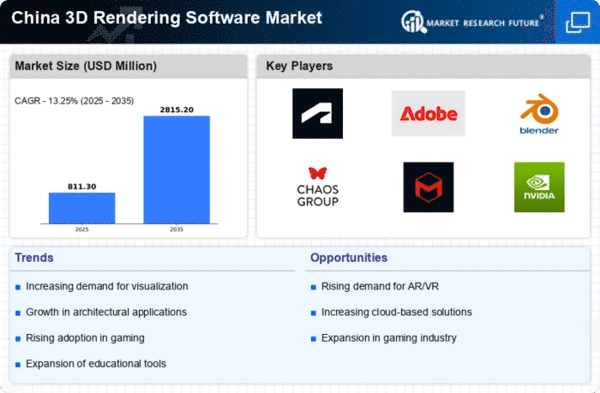The 3D rendering-software market exhibits a dynamic competitive landscape, characterized by rapid technological advancements and increasing demand across various sectors, including gaming, architecture, and film. Key players such as Autodesk (US), Adobe (US), and NVIDIA (US) are strategically positioned to leverage their innovative capabilities and extensive product portfolios. Autodesk (US) focuses on enhancing its cloud-based solutions, which facilitates collaboration and efficiency in design workflows. Meanwhile, Adobe (US) emphasizes integration of its rendering software with other creative tools, thereby fostering a seamless user experience. NVIDIA (US) continues to push the boundaries of real-time rendering through its powerful graphics processing units (GPUs), which are essential for high-quality visual outputs. Collectively, these strategies contribute to a competitive environment that prioritizes innovation and user-centric solutions.
In terms of business tactics, companies are increasingly localizing their operations to better serve the Chinese market, optimizing supply chains to enhance efficiency and reduce costs. The competitive structure of the market appears moderately fragmented, with several players vying for market share. However, the influence of major companies is substantial, as they set industry standards and drive technological advancements that smaller firms often follow.
In October 2025, Autodesk (US) announced the launch of its new cloud-based rendering service, which aims to streamline the design process for architects and engineers. This strategic move is significant as it not only enhances Autodesk's product offerings but also aligns with the growing trend towards digital transformation in the construction industry. By providing a more efficient rendering solution, Autodesk (US) positions itself as a leader in the market, potentially increasing its customer base and market share.
In September 2025, Adobe (US) unveiled a major update to its rendering software, incorporating advanced AI features that enhance image quality and reduce rendering times. This development is crucial as it reflects Adobe's commitment to innovation and its understanding of the increasing demand for faster, high-quality rendering solutions. By integrating AI, Adobe (US) not only improves user experience but also strengthens its competitive edge in a market that is rapidly evolving.
In August 2025, NVIDIA (US) launched a new line of GPUs specifically designed for 3D rendering applications, which promises to deliver unprecedented performance levels. This strategic initiative is likely to solidify NVIDIA's position as a key player in the rendering software market, as it caters to the needs of professionals seeking high-performance solutions. The introduction of these GPUs may also encourage software developers to optimize their applications for NVIDIA's hardware, further enhancing the ecosystem surrounding 3D rendering.
As of November 2025, current trends in the competitive landscape include a strong emphasis on digitalization, sustainability, and the integration of AI technologies. Strategic alliances among companies are increasingly shaping the market, as partnerships enable firms to combine resources and expertise to innovate more effectively. Looking ahead, competitive differentiation is expected to evolve, with a shift from price-based competition towards a focus on innovation, technological advancements, and supply chain reliability. This transition suggests that companies that prioritize these aspects will likely emerge as leaders in the 3D rendering-software market.

















Leave a Comment